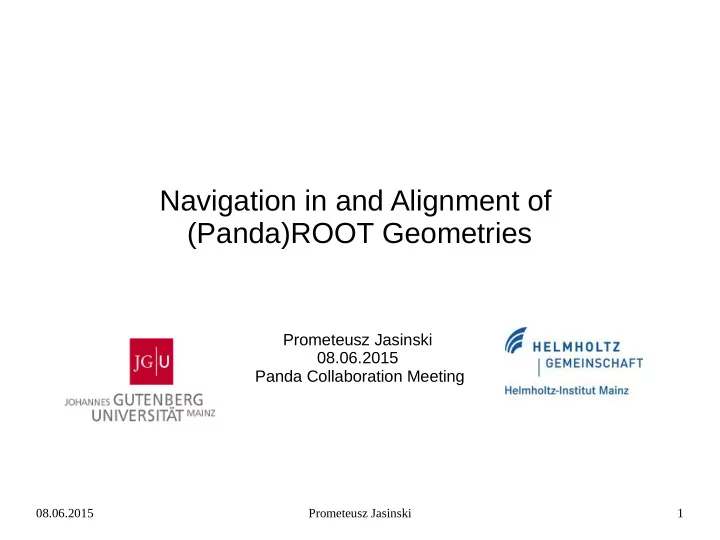

Navigation in and Alignment of (Panda)ROOT Geometries Prometeusz Jasinski 08.06.2015 Panda Collaboration Meeting 08.06.2015 Prometeusz Jasinski 1
Navigation in (Panda)ROOT $ROOTSYS/tutorials/geom/geomAlice.C Reminder: All TGeo* and VMC stuff in root was developed for/by ALICE http://iopscience.iop.org/1742-6596/331/3/032016 08.06.2015 Prometeusz Jasinski 2
3
4
Sketches vs. real world vs. MC 08.06.2015 Prometeusz Jasinski 5
Sketches vs. real world vs. MC Not so easy: Straight forward: Use MVD approach or give sketches create it from scratch in to the workshop ROOT 08.06.2015 Prometeusz Jasinski 6
Mother-Daughter Volume Relations Volume: plane -> Volume: module -> Volume: side (back is rotated!) -> Volume: die (currently not misaligned) Notice: Sensors -> Volume: sensor (not misaligned) contain active AND passive Material Volume: Lumi vacuum Volume: Panda Cave Lumi box Volume: Lumi reference frame Volume: half Pipe for pumping Beam pipe station 10.5 m 08.06.2015 Prometeusz Jasinski 7
Creation of LMD ROOT Geometries $PANDAROOT/lmd/lmdMC/PndLmdDim* - Construction of lumi root geometry (aligned and misaligned) - Lumi constants - Transformation matrices - Interplay with a root geometry How to access/modify transformation matrices in nodes? 08.06.2015 Prometeusz Jasinski 8
ROOT TGeoManager Navigation Quoting Chapter 19 of the root documentation: „Physical nodes are the actual “touchable” objects in the geometry, representing actually a path of positioned volumes starting witrh the top node: path=/TOP/A_1/B_4/C_3 , where A, B, C represent names of volumes. [...] The knowledge of the path to the objects that need to be misaligned is essential since there is no other way of identifying them. One can however create “symbolic links”...“ Tested myself for our geometry: Random access performance is pretty much the same as a std::map (binary search tree) with a dynamically constructed string as a key BUT the path (Sensor ID) can change, when you hand over your geometry to FAIRROOT! 08.06.2015 Prometeusz Jasinski 9
The Complication with the Detector ID and Sensor ID Path when generating the geometry: The copy number is actually the Sensor ID Handing over to FairROOT: Result in the pseudo DB: mother volume changed in the past: copy number changed (seems to be fixed now and DetectorID is used instead) In Principle PndSensorNamePar gives you the path, but only for active volumes! Actually why is it not a FAIRROOT feature? 08.06.2015 Prometeusz Jasinski 10
Alignment of the LMD 1. Align Sensors with respect to each other 1. Align Sensors with respect to each other on a module with hits on a module with hits 2. Align Modules in respect to each other 2. Align Modules in respect to each other via Millipede with tracks via Millipede with tracks 3. Align the LMD with respect to the IP and 3. Align the LMD with respect to the IP and magnetic fields with propagated tracks magnetic fields with propagated tracks -> Touching only mother volumes -> Touching only mother volumes in the geometry tree in the geometry tree If we touch only active material we get clashing volumes! 08.06.2015 Prometeusz Jasinski 11
Matrices in the LMDDim class depth Tkey key 0 = lmd ref frame TgeoMatrix* matrix -1 = half -2 = plane -3 = plane Gain in speed = x 3.5 for random access + access to nearly all matrices of the geometry + geometry does not have to be loaded -4 = module ... 08.06.2015 Prometeusz Jasinski 12
Why is it NOT the wholy grale? Quoting Chapter 19 of the root documentation: [...] it is impossible to create all physical nodes as objects in memory. [...] Question: does it still apply to todays computer farms? AND ... 08.06.2015 Prometeusz Jasinski 13
Two parallel worlds PndLmdDim tree Root Geometry Tkey key TgeoMatrix* matrix Consistency used at some special LMD calculation places used nearly everywhere across PandaROOT for example: (Mis)alignment 08.06.2015 Prometeusz Jasinski 14
Synchronizing PndLmdDim with a root geometry 08.06.2015 Prometeusz Jasinski 15
Synchronizing PndLmdDim with a root geometry 08.06.2015 Prometeusz Jasinski 16
Synchronizing PndLmdDim with a root geometry Warning: those changes are not persistent and must be applied for each task ! And quoting the documentation once more: „The Align() [I'm using it for each matrix to be set] method will actually duplicate the corresponding branch within the logical hierarchy, creating new volumes and nodes. This is mandatory in order to avoid problems due to replicated volumes and can create exhaustive memory consumption if used abusively. „ -> It should be checked if performance is ok, when „(mis)aligning“ the whole Panda Geometry, or do we have to (mis)align and to store as a default geometry? 08.06.2015 Prometeusz Jasinski 17
Conclusion We are able to align and navigate through the geometry. We can perform transformations with our own matrix handler but retaining consistency is a complication. We need common design rules and a common basis before proceeding with DB entries and so on. Would be nice to know the experience from Alice with their own framework. What are the pitfalls? Thank you Remark: I'm leaving Panda on 01.07.15 for a permanent position in the industry. Thank you for the great time here! 08.06.2015 Prometeusz Jasinski 18
Backup 08.06.2015 Prometeusz Jasinski 19
Code examples misalignment: or some tests: 08.06.2015 Prometeusz Jasinski 20
Search tree was: optimized string based key A typical key was: „0 2 1 0 -1 -1“ with the standard „<“ operator therefore not mapping the mother-daughter relations 08.06.2015 Prometeusz Jasinski 21
Reducing the depth of the PndLmdDim tree depth string key 0 TgeoMatrix* matrix -1 -2 -3 map = binary search tree -4 08.06.2015 Prometeusz Jasinski 22
Recommend
More recommend